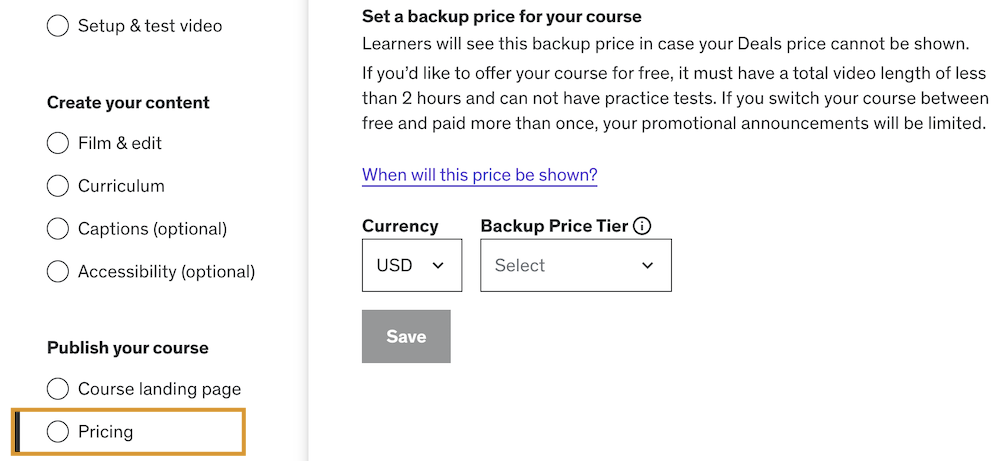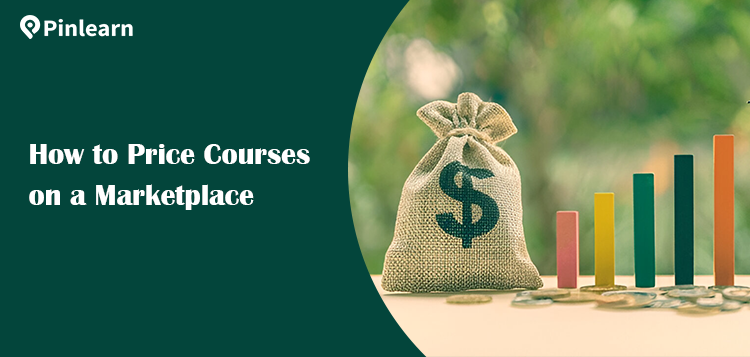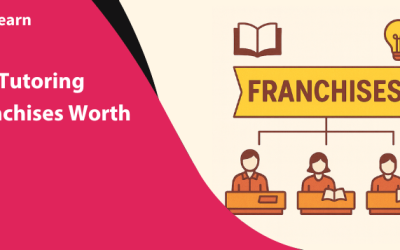How to Price Courses on a Marketplace: Key Strategies & Tips
You have made the best decision of your life by selling online courses. If you’re a beginner, you might even choose to sell on a marketplace to skip the technicalities of hosting and branding. But then you discover there’s a sea of creators selling similar courses.
You wonder whether to price your courses low to attract more sales or price them high to attain your financial goals. Successful course creators use a blend of art, science and market research to price right.
In this guide, we break down the strategies and tips to master pricing your course on a marketplace. From complex commission cuts to knotty promotions, you’ll figure it all out!
What are the Factors Affecting Your Course Price in the Marketplace?
Before we move on to discuss the key steps to price your course, knowing the factors affecting pricing is important. This could help you attract more enrollments and target the right audience.
Here are the factors you need to consider to price a course on a marketplace:
-
Course Depth & Length
The more comprehensive the course, the higher you can price it. Contrastingly, short or mini courses obviously cost less than their larger counterparts. For example, for a 3-hour course, you can charge $30- $50. But, a more comprehensive course extending 50+ hours costs around $100 – $199.99.
-
Marketplace & Competitor Norms
Business model, revenue-sharing, and competitor prices influence course pricing on the marketplace. For pay-per-course platforms like Udemy, the revenue share is per sale. However, for subscription platforms, it’s the course engagement (minutes of video watched).
-
Target Audience
The kind of people and their willingness to pay for courses largely influence your prices. Professionals and businesses pay more when compared to beginners and hobbyists.
-
Instructor Expertise
If you have years of experience in a specific industry, you can seamlessly convert your passion into valuable courses. If you are assured of the outcomes, charge a higher price.
-
Course Development Cost
While course creation costs aren’t a direct factor in pricing your courses, they still affect your profitability. While you can’t cover the extensive course costs, think about it long-term.
How to Price Courses on a Marketplace: 7 Key Steps
Choosing course price on the marketplace differs significantly from standalone courses. The business model, customer psychology, and competition significantly influence your pricing decision.
Let’s navigate through the 7-step guide to price your course right on a marketplace:
Step 1: Understanding the Revenue Model, Tiers & Max Capping
First off, understand how the marketplace works. Each marketplace has a set framework in terms of business model and revenue-sharing. So, knowing the bigger picture makes things easier in the long run!
For example, if you are selling your course on Udemy, learn how the platform works. Udemy follows a commission model where the platform charges a commission between 3% and 63%. So, the remaining revenue goes to the instructor.
The pricing tiers start from $19.99 (tier 1) and go up to $199.99 (tier 37). On top of that, instructors can opt for the Udemy Deals Program, where courses are sold at a discounted price. All you have to do is select a baseline for your course, and you get the optimized pricing recommendations within minutes.

Another important thing to consider here is the maximum cap on pricing. For Udemy, it’s $199.99, and you cannot price your courses above this limit.
Step 2: Determine Your Course Value
Once you grasp the dynamics of your marketplace, it’s time to gauge your course’s worth. Finding your course’s unique value proposition sets you apart.
Ask these questions:
- Is your course addressing a unique problem or skill?
- Does it offer a clear, tangible benefit to learners?
- Are you focusing on a specific niche or transformation?
- Did the course creation involve significant cost?
Most creators offer courses for free or low prices. But, your price influences your “course’s perceived value.” While pricing low might earn you more signups, it doesn’t guarantee sales. People often relate a higher price to a high-quality course.
Besides, marketplaces like Udemy run year-round discounts, ranging from 50%-90%. So, even if the list prices show hundreds of dollars, students probably pay only $10 -$20. So, choosing a high price doesn’t hurt. The final revenue you earn is after reducing the commission cut. So, price strategically.
Source: Udemy Community

Step 3: Research Competitors & Market Dynamics
Competitor analysis is essential in a saturated marketplace like Udemy and Skillshare. To find success selling your courses, you need to fit into the marketplace. The best way to do this is to study similar course offerings. That’s where your Sherlock skills come in!
Pick the top 5 courses in your niche. Look at the content value, pricing range, course length, and outcomes. Ensure your course is priced more or less within the same range. If most courses are listed at $30, charging over $60 won’t make sense unless you offer something exceptional.
Also, look at the promotional deals and bundles they offer. But don’t blindly mimic their moves. Discover a sweet spot between balancing value and costs!
Find the prevalent benchmarks in the market. For example, a basic course could be between $50-$200, while advanced courses cost over $300.
Step 4: Know What Your Audience are Willing to Pay
Does your target audience involve professionals or hobbyists? Is your course offering them a higher ROI or bridging a new professional’s career?
After all, it’s your audience who are paying for your course. So, analyzing their financial capability helps to find out if they can afford your course.
Create detailed audience personas with demographics, pain points, spending habits, etc.
For example, if you’re selling a basic Python course for beginners, you can’t price it high-end. Comparatively, a specialized Python course on machine learning or data science could sell at a higher price.
Also, your course niche matters. Hobby learners prefer a low price range when compared to professionals or corporate clients.
Use surveys and one-on-one interviews to gain deep insights on learner preferences.
Step 5: Offer Tiered Course Prices
If you want to make your course accessible to a larger audience, adopt a tiered pricing.
By this, we mean creating multiple courses for different price points.
For example, if you sell a digital marketing course, you could create a 10-hour digital marketing masterclass, a 3-hour social marketing course, and a 1-hour basic mini course. This helps to maximize your reach and revenue.
Upselling & course bundles curate more comprehensive learning paths. As a result, you offer more value to your learners. Bundle related courses in a package for a discounted price.
However, platforms like Udemy don’t support bundles. A few workarounds could create the same effect as course bundles. For instance, you could combine multiple course lectures under the same topic and sell them as a masterclass.
Alternatively, you could create different courses and coupons for them. Later, bundle the coupons together and sell at a discounted price.
💡 Tip: Integrate templates, worksheets, resources, and certificates in the high-tier courses to make it attractive.
Step 6: Sweeten the Deal with Coupons & Referral Links
Apart from the platform-wide promotions, marketplaces often allow creating instructor coupons.
Udemy is known to offer both platform and instructor coupon codes. Now, these coupons are created by the instructors themselves on the “promotions” page. And it can be shared across social media, emails, or other promotional announcements.
You create a limited-time coupon by selecting the start and end dates. If you receive a request for a discount from a specific student, create a personalized coupon with the student’s name. Additionally, you can try promoting with limited-time free coupons and best-price coupons.

This attracts early enrollments and ensures you win a good volume of course sales!
Referral links are another effective promotional tactic. Instructors can create and share referral links for every paid course. On Udemy, the sales through referral links earn you a 97% revenue share.
Step 7:Review and Adjust Your Course Pricing Regularly
Whether you’re hitting the bull’s eye or running out of sales, evaluating your course prices regularly is important.
Your course prices are not set in stone! You always have the choice to increase or lower the prices.
Keep an eye on the student performance to ensure your efforts are paying off. Listen to their feedback and adjust your prices accordingly. Gather enough social proof to affirm you are heading in the right direction. Testimonials, course reviews and ratings are powerful aids to validate your offerings.
Don’t hesitate to experiment with different price points and promotions. Pick the ones that yield the best results and align with long-term growth. Revisit your prices frequently and tweak as per market trends, financial goals and learner feedback.
Pricing Courses on Marketplace Vs. Standalone Courses
Are you a course creator struggling to decide the right platform for your course? Here’s a quick table comparing the different aspects involved in pricing.
| Key Aspect | Marketplace | Standalone Courses |
| Pricing | Lower pricing | Value-based pricing |
| Perceived Value | Low perceived value due to high-volume and lower-priced offerings | High perceived value and focus is on building authority and credibility |
| Revenue-sharing | Takes a percentage of commission cut from creator revenue | Creators keep the majority of their earnings; minus the transaction and platform fees. |
| Control over Promotion & Bundling | Limited marketing control (rely on referrals, coupons, or deals programs) | Complete control over marketing, bundling, and payment plans |
| Best For | Beginners without audience | Established creators |
How to Price Based on Different Course Types?
Here’s the approximate price range for different course types on marketplaces:
| Course Type | Price Range(List Price) |
| Introductory Courses(1- 2 hours) | $19.99 -$49.99 |
| Intermediate Courses(3-6 hours) | $49.99 – $99.99 |
| Masterclass(50+ hours) | $99.99 -$199.99 |
| Specialized/ Skill-based course | $99.99- $129.99 |
📝Note: Udemy frequently offers sales, so the discounted prices are significantly less from the list price.
Conclusion
Pricing your courses is an integral part of successful course creation. As beginners, identifying the right price might seem intimidating. But, considering a few factors like target audience, course value, and competitor pricing makes it less challenging.
We have outlined the best practices and tips for pricing courses on the marketplace. Your true test is to adjust your pricing as your business grows. Most marketplaces offer limited pricing control, impose high commissions and restrict branding.
With Pinlearn, you can gain complete control over your brand and pricing. Especially if you dream of building your own thriving niche learning community, Pinlearn is all you need! Most importantly, you define your own rules, and don’t need to adhere to marketplace norms. No hidden costs, just a one-time cost to build your own course marketplace!
FAQ-Related to How to Price Courses on a Marketplace
1. How much should I charge for my online course?
Your course pricing depends on your value, audience, and business goals. Typically, courses can be priced between $10 to as high as $2,000 depending on the demand. But if you are selling on marketplaces like Udemy, you need to be in line with similar offerings. Choose a baseline for your course (e.g., $50), consider platform suggestions and strategies. Balance the perceived value with costs to find the right pricing.
2. What factors affect course price on a marketplace?
Consider these factors while pricing a course on the marketplace:
- Perceived value of the course
- Course length & niche
- Target audience
- Competitor Offerings
- Instructor experience
- Course quality and resources
3. Should I price my courses low to attract more students?
While low pricing wins more sign-ups, over time it lowers the perceived value. So, use your course value and market trends as a compass to arrive at the right pricing. Don’t price too low, as you won’t meet your income goals.





